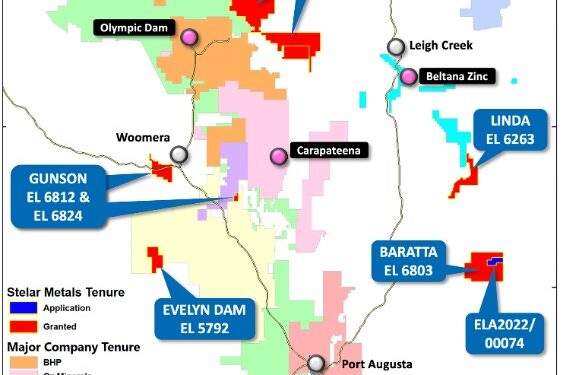Critical minerals explorer Stelar Metals Limited (ASX:SLB) has lodged a 47sq. km Exploration Licence Application (ELA 2022/00074) with the South Australian Government covering the historic Baratta Copper Mine area, immediately adjacent to its recently granted Baratta Project in licence EL 6803.
Baratta, located in northern South Australia, is considered prospective for both Zambian-style Sediment-hosted copper and Rare Earth Element (REE) mineralisation.
The historic Baratta Copper Mine, produced copper ore between 1896 and 1904 from a zone of workings 1.5km long on the northern limb of the Bibliando Dome. The same structure that is interpreted to control copper mineralisation at the Baratta mine is exposed over a significant strike length in the eastern part of Stelar’s granted Baratta tenement EL 6803 and is considered prospective for copper, lead and zinc.
The Baratta Copper Project is underlain by rocks of the Adelaide Fold Belt that share important geological characteristics with the Central African Copperbelt. Stelar recognises the potential for Zambian-style copper mineralisation (sediment-hosted copper deposit – SHCD) as well as REE, which is also supported by the recent copper and REE discoveries made by Taruga Minerals at Wyacca and other prospects, directly west along strike from Stelar’s tenure.
Baratta is one of five highly prospective battery metal projects the Company intends to explore, committing to an aggressive exploration programme in this world-class mining district.
“Our new application over the Baratta Mine area has potential to be a significant addition to Stelar’s Baratta Project,” CEO, Colin Skidmore, said.
“In its day, the Baratta Mine was a major project that reportedly produced ~1,000 tons of 30% copper ore. Modern exploration has been limited, yet there are some great datasets available for re-processing and interpretation that we expect will generate fresh targets for future drill testing. Stelar looks forward to starting field work on the Baratta Project this week.”
Previous Exploration
The historic Baratta Mine area was explored by various companies during the 1960’s and 1970s including Cominco, PetroCarb, North Broken Hill and Western Mining, who undertook various geophysical surveys and limited drill testing. More recently Minotaur Resources, which adopted a IOCG target model between 1996 to 2001, collected high-resolution geophysics and completed a single deep diamond hole to 753.3m depth, and eight reverse circulation (RC) holes into the Bibliando prospect on ELA 2022/00074.
Panda Mining Pty Ltd (Panda) explored the broader Baratta area from 2007 to 2016. Soil sampling using handheld XRF over several grids detected copper-cobalt anomalism northeast along strike of the historic Baratta Copper Mine.
Mapping over the Baratta Copper Prospect area indicated copper was hosted by a 1.0m-wide flat-dipping quartz-haematite gossan that was semi-continuous over 1.5km of strike length. 200m spaced rock-chip sampling over the Bibliando Diapir located diapiric gossans with copper mineralisation and highly sulphidic quartz veining.
In May 2010, a detailed airborne magnetic and radiometric survey was flown on 100m-spaced flight lines and in 2014, an intermediate gradient IP survey was undertaken over a 64km2 grid with a station spacing of 40m by 200m spaced traverses which also extended over parts of the new tenement application.
Exploration Models
Stelar considers that several exploration models are valid for the project area. The Adelaidean sequence is prospective for Zambian-style SHCDs (sediment-hosted copper deposit), Rare Earth Element (REE) mineralisation as well as zinc-lead mineralisation such as Beltana in South Australia. Beltana is a very high-grade willemite deposit associated with a halokenetic structure (salt diapir) and shares key features with the large and high-grade Kipushi deposit in the Central African Copperbelt.
Next Steps
Stelar will start initial work programmes on the granted Baratta Exploration Licence this week, which will include geological mapping, soil sampling and rock-chip sampling focusing on the Tindelpina Shale Member and the diapiric structures to refine targets for future drill testing. Stelar will also evaluate the rare earth element mineral potential of this project.
The available existing geophysical datasets are also being compiled and reprocessed to assist in determining geology and the structural architecture as well as target generation for future drill programmes.
For further information please visit: https://stelarmetals.com.au/












